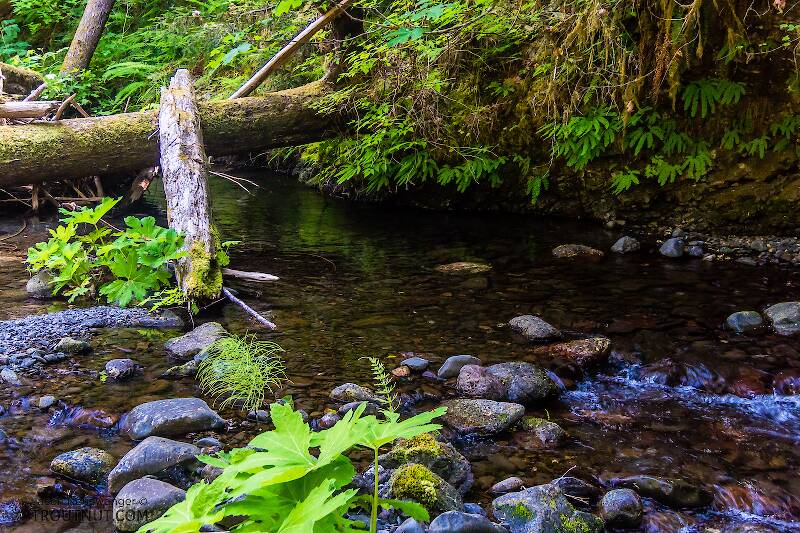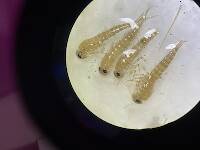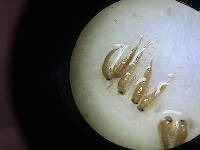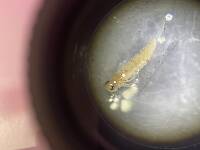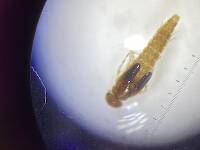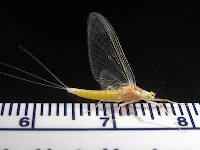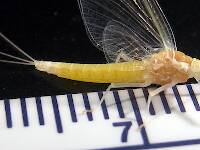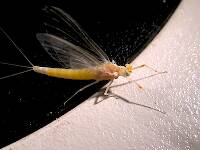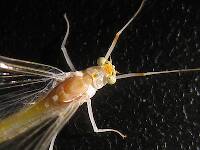
Blue-winged Olives
Baetis
Tiny Baetis mayflies are perhaps the most commonly encountered and imitated by anglers on all American trout streams due to their great abundance, widespread distribution, and trout-friendly emergence habits.
Featured on the forum
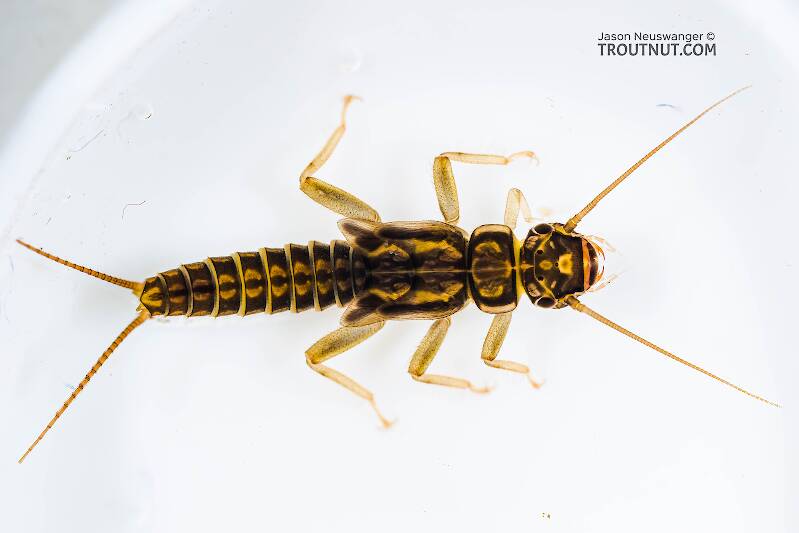

Troutnut is a project started in 2003 by salmonid ecologist Jason "Troutnut" Neuswanger to help anglers and
fly tyers unabashedly embrace the entomological side of the sport. Learn more about Troutnut or
support the project for an enhanced experience here.

This dun of a fairly large Baetidae species was one of only a couple I saw all evening.
Troutnut on Aug 27, 2006August 27th, 2006, 4:56 pm EDT
This dun seems to belong to one of those two genera. Does anybody know how to tell them apart? I can't find anything that doesn't require a male spinner.
Jason Neuswanger, Ph.D.
Troutnut and salmonid ecologist
Troutnut and salmonid ecologist
Martinlf on Jun 25, 2012June 25th, 2012, 8:45 am EDT
Does anyone know how much color variation is found in Centroptilum and Procloen (since nobody seems to know how to tell them apart from a quick visual exam without a male spinner). The bugs in Jason's photo above look significantly more olive-yellow than the Centroptilum samples Kurt posted up from Fall River. The bugs I'm seeing now are more what Eric describes when he talks about a cream abdomen and yellow thorax. The spinners, which fall in the morning are more tan overall, though I recently found one with a yellowish thorax (unless it was an early dun, or something altogether different). Also I wonder if anyone has fished over a Plauditus dubius hatch, and what those little devils look like. They seem like another candidate for the summer olives we've been discussing.
"He spread them a yard and a half. 'And every one that got away is this big.'"
--Fred Chappell
--Fred Chappell
Entoman on Jun 25, 2012June 25th, 2012, 9:48 am EDT
There is a fair amount of intraspecific variability regarding both size and color. They seem to have cream as a base with highlights of tan, yellow, olive, and even orange in some strains. Macrophotography definitely shows details not noticable in the hand and alters the perception. For example, the Fall river specimen looks more creamish in the hand than the photos show. The ventrals are entirely pale cream with a hint of yellow.
As far as identifying them in the field, if the eyes are good enough (mine aren't anymore:)) and with the help of a little magnification, the slender little hind wings with hook shaped projections and single intercalaries in the forewings can usually be seen. If these characters can be made out, and the bugs are pale, the hatch is most likely in this Centroptilum/Procloeon group.
As far as identifying them in the field, if the eyes are good enough (mine aren't anymore:)) and with the help of a little magnification, the slender little hind wings with hook shaped projections and single intercalaries in the forewings can usually be seen. If these characters can be made out, and the bugs are pale, the hatch is most likely in this Centroptilum/Procloeon group.
"It's not that I find fishing so important, it's just that I find all other endeavors of Man equally unimportant... And not nearly as much fun!" Robert Traver, Anatomy of a Fisherman
Konchu on Jun 25, 2012June 25th, 2012, 11:59 am EDT
I reared Plauditus this spring and took pictures to upload here, along with some rare bugs. I need to do that one of these days... The number of intercalaries in the wings (1 vs. 2) will distinguish Cloeon group genera from Plauditus in North America.
Konchu on Jun 25, 2012June 25th, 2012, 12:01 pm EDT
PS, the shape of the head can be helpful placing the centroptilum/procloeon things in a field ID. At the moment, I don't remember which one looks which way, but maybe some resourceful souls here can figure it out with this prompt.
Entoman on Jun 25, 2012June 25th, 2012, 7:01 pm EDT
Louis -
Undoubtedly. Plauditus dubius (prev. Pseudocloeon dubium) AKA Tiny Olive among other names is a fairly common and widespread little baetid that can be important to eastern anglers. As small as 3mm, these guys are ridiculously tiny. The come mostly in shades of olive and brown, but Dr. Chandler has a great picture of one over at his site that looks to be a combination of both and somewhat paler than usually described. http://www.discoverlife.org/mp/20p?res=md&see=I_DSC376;I_DSC377;I_DSC378;I_DSC240;&start=/mp/20q%3Fsearch%3DPlauditus The distinguishing characteristics are the double intercalaries (they show well in Dr. Chandler's photo) and lack of hind wings. Older keys and descriptions used to depend on the shape and presence (or lack thereof) of hind wings as well as their shape & venation to aid in determining the genus & species of these small baetids. That worked fine for the vast majority of the ones North American anglers see, but this methodology caused many taxonomic difficulties to say the least. Edmunds reported back in the 70's that he was certain the practice was dubious, but deemed it impractical at the time to revise the nomenclature until more studies were done. Since then, many of the single intercalary spur winged Centroptilum have been moved around, as have the single intercalary Cloeon that lack hind wings all together. The same has happened with all the old double intercalaried hind wingless Pseudocloeon species. In fact, as of this writing there aren't even any NA species left in that genus.
As to the differences between Procloeon and Centroptilum, both can have hind wings or not and the latest keys I'm aware of depend on the shape of male genitalia to tell them apart. Lacking a good look at those, it is often possible to determine the species first using the older descriptions and distribution data to come up with a name and then look to see where it is placed in the current taxonomy. A fair number of the baetids we anglers usually see can be pretty straight forward in this regard. Though the old rules regarding the presence or absence of hind wings to determine genus and their venation and shape to determine species are no longer strictly valid, I believe it's still a good place to start for field ID's related to our purposes.
Luke -
Interesting... I haven't a clue. I don't remember ever hearing (or noticing) this before, but will look into it.
Also I wonder if anyone has fished over a Plauditus dubius hatch, and what those little devils look like. They seem like another candidate for the summer olives we've been discussing.
Undoubtedly. Plauditus dubius (prev. Pseudocloeon dubium) AKA Tiny Olive among other names is a fairly common and widespread little baetid that can be important to eastern anglers. As small as 3mm, these guys are ridiculously tiny. The come mostly in shades of olive and brown, but Dr. Chandler has a great picture of one over at his site that looks to be a combination of both and somewhat paler than usually described. http://www.discoverlife.org/mp/20p?res=md&see=I_DSC376;I_DSC377;I_DSC378;I_DSC240;&start=/mp/20q%3Fsearch%3DPlauditus The distinguishing characteristics are the double intercalaries (they show well in Dr. Chandler's photo) and lack of hind wings. Older keys and descriptions used to depend on the shape and presence (or lack thereof) of hind wings as well as their shape & venation to aid in determining the genus & species of these small baetids. That worked fine for the vast majority of the ones North American anglers see, but this methodology caused many taxonomic difficulties to say the least. Edmunds reported back in the 70's that he was certain the practice was dubious, but deemed it impractical at the time to revise the nomenclature until more studies were done. Since then, many of the single intercalary spur winged Centroptilum have been moved around, as have the single intercalary Cloeon that lack hind wings all together. The same has happened with all the old double intercalaried hind wingless Pseudocloeon species. In fact, as of this writing there aren't even any NA species left in that genus.
As to the differences between Procloeon and Centroptilum, both can have hind wings or not and the latest keys I'm aware of depend on the shape of male genitalia to tell them apart. Lacking a good look at those, it is often possible to determine the species first using the older descriptions and distribution data to come up with a name and then look to see where it is placed in the current taxonomy. A fair number of the baetids we anglers usually see can be pretty straight forward in this regard. Though the old rules regarding the presence or absence of hind wings to determine genus and their venation and shape to determine species are no longer strictly valid, I believe it's still a good place to start for field ID's related to our purposes.
Luke -
PS, the shape of the head can be helpful placing the centroptilum/procloeon things in a field ID. At the moment, I don't remember which one looks which way, but maybe some resourceful souls here can figure it out with this prompt.
Interesting... I haven't a clue. I don't remember ever hearing (or noticing) this before, but will look into it.
"It's not that I find fishing so important, it's just that I find all other endeavors of Man equally unimportant... And not nearly as much fun!" Robert Traver, Anatomy of a Fisherman
Martinlf on Jun 25, 2012June 25th, 2012, 8:39 pm EDT
Hmm. Shawn found a tiny olive that hatches in the evening a few years back. I think we were fishing in July. As I recall the nymphs were very dark, and the duns olive. We watched one hatch in a net that had been placed in the surface of the water. The fish were very active. Does anyone know when Plauditus dubius hatches, or what the bug we found might be? I know there is a "dubious" joke somewhere in all this, but I haven't hit upon it yet.
"He spread them a yard and a half. 'And every one that got away is this big.'"
--Fred Chappell
--Fred Chappell
Taxon on Jun 25, 2012June 25th, 2012, 8:53 pm EDT
Hi Louis-
Ask, and ye shall receive:
Ask, and ye shall receive:
Family name: Baetidae
Scientific name: Plauditus dubius
Previously know as: Baetis dubius, Cloe dubia, Cloeon chlorops, Cloeon dubium, Pseudocloeon chlorops, Pseudocloeon dubium
Common name: Little Slatewinged Brown Quill, Bluewinged Olive
Locality: E, M, W
CAN Regions: NE,NW
MEX Regions:
USA Regions: FN,NE,SE
Cent. Amer. Countries:
CAN Provinces: AB, MB, NB, NS, ON, QC, SK.
MEX States:
USA States: AL,AR,CT,FL,GA,IA,ID,IL,IN,KY,ME,MI,MN,MO,MS,MT,NC,NE, NY,OK,OR,PA,SC,TN,TX,VA,WI,WV.
Habitat:
Voltinism:
Emergence (begin) date: early-Jun
Emergence (end) date: mid-Jul
Emergence time of day:
Spinner fall time of day:
Nymph minimum length: 3 mm.
Nymph maximum length: 5 mm.
Nymph identification keys: tergites 3-4, 8-10 pale
Nymph body description: brownish olive w/abdominal segments 3,4,8,9,10 paler
Nymph legs: pale olive
Nymph gills:
Nymph tusks:
Nymph tails: 2, pale olive w/banding at middle
Dun minimum length: 4 mm.
Dun maximum length: 4 mm.
Dun identification keys:
Dun body description: light olive to dark brown
Dun wings: light to medium gray
Dun legs: pale olive gray
Dun tails: 2, pale gray
Spinner minimum length: 3 mm.
Spinner maximum length: 4 mm.
Spinner identification keys: eyes reddish-brown
Spinner body description: thorax light brown, abdominal segments 2-6 whitish, 7-10 yellowish brown
Spinner wings: fore wings w/detached intercalary veins, hind wings absent
Spinner legs: (male) fore femora pale reddish brown
Spinner tails: 2,
Entoman on Jun 25, 2012June 25th, 2012, 9:49 pm EDT
Louis -
Do you remember if the nymph looked a little stocky for a baetid?
BTW -
So, you don't like puns?
Do you remember if the nymph looked a little stocky for a baetid?
BTW -
I know there is a "dubious" joke somewhere in all this, but I haven't hit upon it yet.
So, you don't like puns?
Edmunds reported back in the 70's that he was certain the practice was dubious...
"It's not that I find fishing so important, it's just that I find all other endeavors of Man equally unimportant... And not nearly as much fun!" Robert Traver, Anatomy of a Fisherman
Martinlf on Jun 26, 2012June 26th, 2012, 12:21 pm EDT
Missed it, Kurt.
Shawn, do you remember what the nymphs looked like? One of us will have to try to photograph a nymph and a dun and post it up if possible.
Shawn, do you remember what the nymphs looked like? One of us will have to try to photograph a nymph and a dun and post it up if possible.
"He spread them a yard and a half. 'And every one that got away is this big.'"
--Fred Chappell
--Fred Chappell
GONZO on Jun 26, 2012June 26th, 2012, 6:54 pm EDT
Jason,
I lean toward this specimen being Procloeon, partly because its size fits easily into the size range of members of the "Pennulatum Group" and partly because the head markings (median brown area) and abdominal markings (black lateral streaks, fine black "veining," and pale reddish brown markings in the form of a "round edged 'W'") are mentioned in descriptions of Procloeon quaesitum females by McDunnough (1931) or Lowen and Flannagan (1992). Procloeon rivulare might be another candidate for consideration, but (as far as I know) the only published description of that species is Traver's original description from the The Biology of Mayflies (1935). I don't have convenient access to that source, so perhaps someone who does could look into Traver's description of that species.
Konchu,
The only "head-related" characters that I've encountered that might be helpful for distinguishing between females of Centroptilum and Procloeon have to do with eye size and separation. From what I gather, the eyes of female Centroptilum are smaller and set farther apart than the eyes of female Procloeon (which are larger and closer together). Kluge and Novikova (1992) describe the difference this way:
Centroptilum--"eyes of female not enlarged and not close together"
Procloeon (including "Pennulatum Group")--"Eyes of female large, approximated, inner margins parallel, distance between them equal to eye length; eyes also clearly protruding above head" (This description seems to fit this specimen well.)
Are these the characters you had in mind?
I lean toward this specimen being Procloeon, partly because its size fits easily into the size range of members of the "Pennulatum Group" and partly because the head markings (median brown area) and abdominal markings (black lateral streaks, fine black "veining," and pale reddish brown markings in the form of a "round edged 'W'") are mentioned in descriptions of Procloeon quaesitum females by McDunnough (1931) or Lowen and Flannagan (1992). Procloeon rivulare might be another candidate for consideration, but (as far as I know) the only published description of that species is Traver's original description from the The Biology of Mayflies (1935). I don't have convenient access to that source, so perhaps someone who does could look into Traver's description of that species.
Konchu,
PS, the shape of the head can be helpful placing the centroptilum/procloeon things in a field ID. At the moment, I don't remember which one looks which way, but maybe some resourceful souls here can figure it out with this prompt.
The only "head-related" characters that I've encountered that might be helpful for distinguishing between females of Centroptilum and Procloeon have to do with eye size and separation. From what I gather, the eyes of female Centroptilum are smaller and set farther apart than the eyes of female Procloeon (which are larger and closer together). Kluge and Novikova (1992) describe the difference this way:
Centroptilum--"eyes of female not enlarged and not close together"
Procloeon (including "Pennulatum Group")--"Eyes of female large, approximated, inner margins parallel, distance between them equal to eye length; eyes also clearly protruding above head" (This description seems to fit this specimen well.)
Are these the characters you had in mind?
Konchu on Jun 27, 2012June 27th, 2012, 5:22 am EDT
Yep, I think that's it! However, one must be careful using Eurasian scientists' concepts of genera compared to the concepts of genera that have been applied in North America.
GONZO on Jun 27, 2012June 27th, 2012, 5:46 am EDT
Thanks, Konchu. With regard to varying concepts of genera, perhaps I should have made it clear that Kluge and Novikova (1992) were dealing with Centroptilum and Procloeon as subgenera of Cloeon and that their concept of Procloeon was somewhat narrower than the treatment as a genus in McCafferty and Waltz (1990):
In terms of a whole series of characters the type species of the genus Procloeon is close to the Pennulatum Group, which until now has been assigned to the genus Centroptilum; therefore we believe it makes sense to unite in a single subgenus Procloeon and the Pennulatum Group and expand the diagnosis of this subgenus with new characters. McCafferty and Waltz (1990) also include the Pennulatum Group in Procloeon, but treat Procloeon as a genus and more broadly than we do, including in it all of Cloeon s. l. except for Cloeon s. str., Centroptilum, and Pseudocentroptiloides.
Entoman on Jun 27, 2012June 27th, 2012, 9:48 am EDT
Gonzo,
I plead guilty to influencing Jason to put this specimen under C. album last year. It was removed from the limbo of family listing and tentatively placed there for just this kind of discussion. There were two threads started on this guy by accident and the placement discussion took place on the other one. Please take a look regarding my rationale for your comment. The only thing I would add to them is that the dark tracheal lines on pale terga were considered a Centroptilum character prior to the revisions. I've added this bit of info for other Centroptilum determinations but left it out in the commentery on this one for some reason. For those nearctic species later moved to Procloeon, I assume this would still apply to them. The information about the eyes is certainly compelling. What a great way to tell them apart if it holds true for nearctic species as well. This specimen certainly looks to be evidence of this.
I wasn't aware any of them (Procloeon) grew this big. It was my understanding that the biggest species remained in Centroptilum as synonyms of C. album, but I read in Schwiebert's nymphs that P. quaesitum (prev. Centroptilum quaesitum) can certainly grow this large. He also mentions their extremely narrow hind wings and his color descriptions are very close as well. Distribution may be problematic as I can't find a list that shows it for NY. It does have a NE distribution so perhaps Jason's admonition that distribution lists are good evidence of inclusion but not necessarily of exclusion applies here. Though I have found P. rivulare in NY listings, information regarding size shows it to be a substantially smaller critter. Also, though similarly colored and marked, I don't think their hind wings are this severely slim.. I know Taxon has a copy of TBOM, so perhaps he'll read this and comment.
I plead guilty to influencing Jason to put this specimen under C. album last year. It was removed from the limbo of family listing and tentatively placed there for just this kind of discussion. There were two threads started on this guy by accident and the placement discussion took place on the other one. Please take a look regarding my rationale for your comment. The only thing I would add to them is that the dark tracheal lines on pale terga were considered a Centroptilum character prior to the revisions. I've added this bit of info for other Centroptilum determinations but left it out in the commentery on this one for some reason. For those nearctic species later moved to Procloeon, I assume this would still apply to them. The information about the eyes is certainly compelling. What a great way to tell them apart if it holds true for nearctic species as well. This specimen certainly looks to be evidence of this.
I wasn't aware any of them (Procloeon) grew this big. It was my understanding that the biggest species remained in Centroptilum as synonyms of C. album, but I read in Schwiebert's nymphs that P. quaesitum (prev. Centroptilum quaesitum) can certainly grow this large. He also mentions their extremely narrow hind wings and his color descriptions are very close as well. Distribution may be problematic as I can't find a list that shows it for NY. It does have a NE distribution so perhaps Jason's admonition that distribution lists are good evidence of inclusion but not necessarily of exclusion applies here. Though I have found P. rivulare in NY listings, information regarding size shows it to be a substantially smaller critter. Also, though similarly colored and marked, I don't think their hind wings are this severely slim.. I know Taxon has a copy of TBOM, so perhaps he'll read this and comment.
"It's not that I find fishing so important, it's just that I find all other endeavors of Man equally unimportant... And not nearly as much fun!" Robert Traver, Anatomy of a Fisherman
GONZO on Jun 27, 2012June 27th, 2012, 3:34 pm EDT
Though I have found P. rivulare in NY listings, information regarding size shows it to be a substantially smaller critter. Also, though similarly colored and marked, I don't think their hind wings are this severely slim.. I know Taxon has a copy of TBOM, so perhaps he'll read this and comment.
Roger has graciously provided me with a copy of Traver's original description of rivulare. Based on that, I cannot find a truly convincing reason to rule it out as a possibility. In short, P. quaesitum, P. rivulare, and even P. pennulatum all seem like possibilities to me. However, I do think that Procloeon seems more likely than Centroptilum.
Entoman on Jun 27, 2012June 27th, 2012, 7:38 pm EDT
... I do think that Procloeon seems more likely than Centroptilum.
I agree, so the "eyes" have it.:) That's great information regarding them, so thanks very much for sharing it.
Luke - thanks for posing the question.
Lloyd - I'm leaning towards your initially mentioned possibility of P. quaesitum over size and hind wing characters. Would you mind sharing why you think Traver's descriptions were inconclusive regarding rivulare? As to pennulatum, the hind wing is substantially different from Jason's specimen. See Lowen & Flannagan (1990).
"It's not that I find fishing so important, it's just that I find all other endeavors of Man equally unimportant... And not nearly as much fun!" Robert Traver, Anatomy of a Fisherman
GONZO on Jun 27, 2012June 27th, 2012, 8:36 pm EDT
Lloyd - I'm leaning towards your initially mentioned possibility of P. quaesitum over size and hind wing characters. Would you mind sharing why you think Traver's descriptions were inconclusive?
Sure.
The only thing that didn't seem to fit reasonably well in Traver's description of rivulare was that this specimen is about 1mm larger than the size range given for the body. An original description is typically based on a very small sample; in this case, all collected from the same place at the same time. I don't find that to be a compelling reason to rule out rivulare based only on size. (The hindwing character was expressed as "relatively long and narrow, much as in C. ozburni....")
For example, suppose that this specimen was 8mm instead of 7mm. If I were using only the size given in McDunnough's original description of quaesitum, that would make this specimen 1mm larger than the size he gives. However, the later (re)descriptions of Lowen and Flannagan include (adult) specimens as large as 9.2mm. The more information--in terms of reliable descriptions, redescriptions, and larger samples over time and distance--the better the picture of the range of variation within a species becomes.
I think it is also good to keep in mind that we are dealing with baetids, and they can have multiple generations and/or extended emergences. In either instance, I have seen quite a bit of variation in size between different generations or between earlier and later portions of an extended emergence.
Question for question: If you are leaning toward quaesitum, what are your reasons for eliminating pennulatum?
Entoman on Jun 27, 2012June 27th, 2012, 8:54 pm EDT
Sorry Lloyd - I edited my previous post regarding pennulatum while you were writing your response.
"It's not that I find fishing so important, it's just that I find all other endeavors of Man equally unimportant... And not nearly as much fun!" Robert Traver, Anatomy of a Fisherman
GONZO on Jun 27, 2012June 27th, 2012, 9:48 pm EDT
As to pennulatum, the hind wing is substantially different from Jason's specimen. See Lowen & Flannagan (1990).
I've seen Lowen and Flannagan 1990, Kurt, but I've also seen Ulmer 1929, Mikulski 1936, Schoenemund 1930, and Bogoescu 1958. They all depict the hindwing of pennulatum, and all are slightly different--some are longer, some are shorter, some are curved, some are straighter. What I notice most of all is that none of them depict a hindwing with its upper (anterior) edge tilted toward the camera so that only one of the longitudinal veins is visible in most of the photos.
How about if we just agree to "probably Procloeon" and call it a night? ;)
Entoman on Jun 27, 2012June 27th, 2012, 9:56 pm EDT
How about if we just agree to "probably Procloeon" and call it a night? ;)
Ha! You asked... besides why quit when there's so much more to "speculate" over! :)LOL
No, I agree - have a good night.
"It's not that I find fishing so important, it's just that I find all other endeavors of Man equally unimportant... And not nearly as much fun!" Robert Traver, Anatomy of a Fisherman
Quick Reply
Related Discussions
Topic
Replies
Last Reply
0
May 3, 2007
by Troutnut
by Troutnut
8
Jun 5, 2007
by Dinerobyn
by Dinerobyn
12
Oct 29, 2013
by Macalistair
by Macalistair

